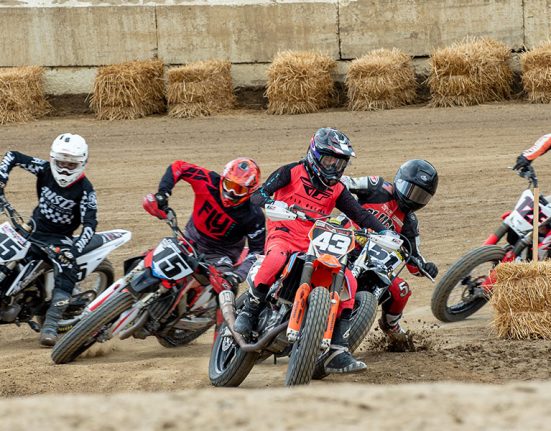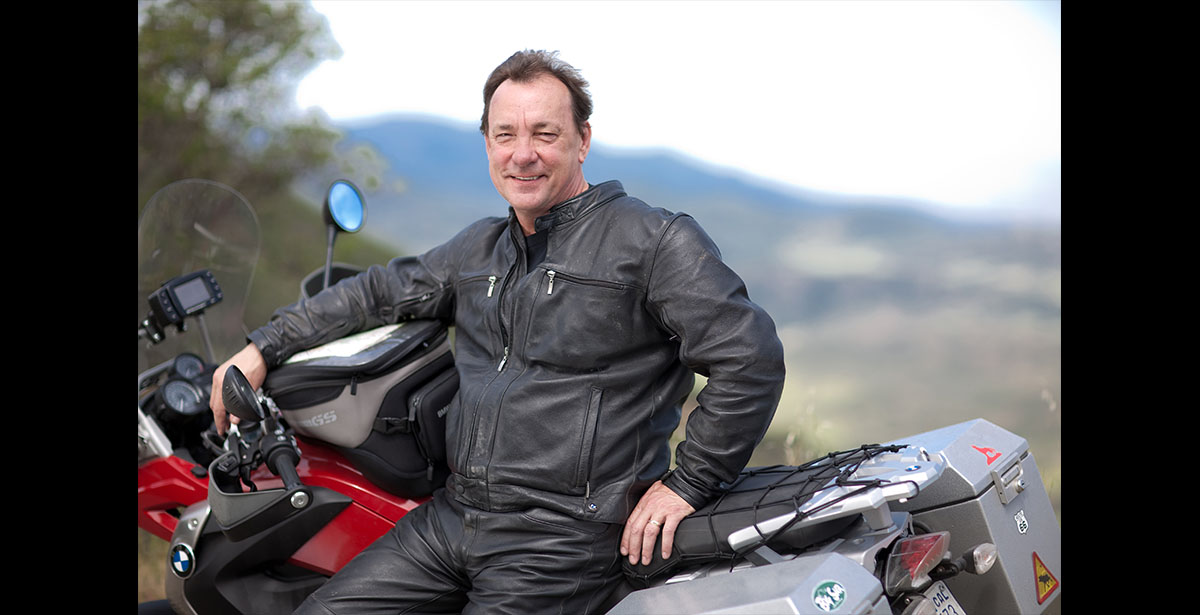Neil Peart, drummer and lyricist for the rock band Rush, died of brain cancer Jan. 7. He was 67. This article originally appeared in the September 2009 issue of American Motorcyclist magazine
By Richard J. Atkins, Ed.D
Feature Photography by Holly Carlyle

Neil Peart has clocked almost 300,000 miles on two wheels. And he still rides relentlessly.
Touring with the monumental group Rush, he’s spent his nights behind the drum kit, driving the complex beats of “Tom Sawyer,” “Sprirt of Radio,” “Fly By Night”—and delivering some of rock ‘n’ roll’s most iconic drum solos. He may even be, as some magazines have dubbed him, the world’s greatest living rock drummer.
But during those tour days, he’s on his motorcycle, riding between shows, Peart has covered 45,000 miles on two wheels in the past two years alone, traveling coast to coast, through Canada and Europe. And that’s only the start of a passion for motorcycles that has seen him chronicle some of his adventures in two books. Roadshow details his 2004 concert tour and the motorcycle journeys intertwined with it, while the more introspective Ghost Rider chronicles a wandering, 55,000-mile trip around North America for 14 months looking for a “way back to life” after family tragedies.
Of course, there is also his professional résumé, which could be the subject of endless discussion. Peart is an officer of the prestigious Order of Canada and is the drummer and lyricist with Rush, responsible for releasing 34 albums and selling more than 40 million units worldwide since 1974. Peart has, in fact, received so many awards from Modern Drummer and Drum! magazines, that he’s ineligible for some of the award categories because he’s swept the readers’ polls too many times.
The real Peart is a true gentleman and a delightfully charming, generous, humble, humorous and erudite character. His life experiences, writing, music and motorcycling adventures are compellingly inspirational. Getting up close and personal is the perfect opportunity to explore his unique perspective on this shared gift of motorcycling.
Peart’s most impressive quality is his dedication to achieving his personal best in every aspect of life. There is a full enthusiasm for living, coupled with a careful consideration of precision in everything he does, and it’s contagious.
By knowing and riding with him, you start to hear yourself say things like, “Make that turn the best turn you could possibly make,” or “Ride that mountain road as though you’ll never ride another!” Whether it’s his lane position while riding, or his dedication to wearing complete riding gear for every ride no matter how short, Neil’s success derives from unyielding discipline. Realistically, how many average riders always wear full safety gear? Then again, how many average drummers can play “Tom Sawyer”?
Don Argento (marketing director of the AMA Motorcycle Hall of Fame Museum) and I met with Neil to award him an Honorary Life Membership in the American Motorcyclist Association. Part of that get-together included a discussion about riding…
On His First Experience On Two Wheels
My first motorcycle experience was a real lesson! When I was about 12 years old, my dad let me have a mini-bike. I was riding it through an amusement park in Port Dalhousie, Ontario, the town where I grew up. I came to the end of the midway, near the beach, and there was sand across the tarmac. I slid sideways, and found myself riding across the door of a parked Volkswagen Beetle. There was a guy sitting in it reading a newspaper, and I still remember his shocked expression!
I only damaged that little chrome strip on the false running board of his Beetle. The guy agreed to meet me secretly so I could pay for the damage without my parents finding out. That scared me off motorcycles for a long time, and was a formative frightening experience—I didn’t hurt myself, but it shook me up all right. That made me treat motorcycling with more respect, but still, I always said, “When I grow up, I’ll get a motorcycle.”
On Learning To Ride For Real
I started out with a very good training course, held at a college in Toronto, something equivalent to the MSF. It was a three-day course, and they drilled things like shoulder checks and lane position into my head for all time—instilling the basic life-protection techniques. Also, learning to handle a motorcycle wasn’t easy for me, and it took three tries for me to pass that test—so that made me take it very seriously, too.
Later, I did a lot of reading of magazines and books on the subject. Anything that anybody had to say about safe and strategic riding, my ears were open. Now those strategies are so ingrained that, in the course of a ride, if I’m surprised by something that happens in traffic, I get mad at myself—it just shouldn’t happen.
When I first started riding, a friend and early mentor of motorcycling, Mendelson Joe, gave me a sticker that said, “CONCENTRATE.” I put that on my motorcycle, and the reminder was always there every time I’d start my bike. About six months later, I peeled it off. I wrote to Joe and said, “Joe, I’m confident enough on the machine now that I feel that if something happens, it won’t be my fault.” Joe wrote back, “It’s always your fault”—which I understand. Of course, it doesn’t account for a dump truck losing its brakes and T-boning you, volcanoes erupting, or any number of day-ruining things like that!
On What He Likes In A Bike
I always looked at BMWs, the old black-with-the-white-pinstripe kind, the old airheads. To me, that was what a motorcycle should look like. I always knew I would have a BMW when I rode.
The BMW GS model was the first bike I bought myself—the 1100 GS, around 1995 [the “Ghost Rider” bike, which covered over 100,000 miles and is currently displayed in the AMA Museum, along with Neil’s custom drumset from Rush’s 30th Anniversary Tour]. I’ve had an 1150 GS, and three 1200s, because there’s no better bike for all the things that I like—it has the most flexibility, it’s the ultimate expression of versatility. It’s fast and agile enough for me on twisty paved roads, capable on gravel roads, and it’s great for long distance.
I like to ride a lot of dirt roads—the places they can take you to are interesting, and just surviving them can be a challenge, and thus a satisfaction. I look for a little bit of unpaved road somewhere just about every day, because that’s part of the dual-sport mentality. I’ve ridden across the country a few times, and done the “Iron Butt” 1,000-mile day—as comfortably as that can ever be! Last summer I rode over 20,000 miles, and 25,000 the year before.
So I just need one bike, really—the GS. As far as a vehicle for my adventures, it’s the perfect bike.
On Doing Concert Tours By Motorcycle
I’ve been touring the United States for 35 years. So I’ve covered a lot of territory, and a lot of roads. It’s a matter of finding the most interesting ones. Maybe it’s an area I haven’t seen, a village on the map that looks interesting, or has an interesting name. A road I haven’t been on before is endlessly attractive.
Basically, it’s a way to combine a thing I have to do—which is work, like all of us$madsh;and being fortunate enough to be able to commute to work on the motorcycle. My bandmates prefer flying, so I tour with my own bus, for sleeping on, and a trailer for the bikes. After the show, we usually drive a few hours, then park in a rest area. We get up in the morning, have breakfast, unload the bikes, and start riding.
Every show day, I spend time on the bus putting together routes, looking at where we have to go, and how we might get there. Planning a day off allows a lot more latitude, but if it’s a show day, I’ll figure out how much traveling I can do off the beaten track and still get to work on time.
I like the term “shunpiking”—avoiding all major roads and seeking out the back roads, the gray lines on the map. I highlight the route I want to take and then give that to my riding partner, Michael (Mosbach), who will transfer it onto his computer and download it to our GPS receivers. We start the next day with the whole route mapped out, knowing how long it should take us.
On The Importance Of Punctuality
Our ETA on the show day is very important. Sound check is 5 p.m., so I like to be there by 3 p.m. or so to have time to look after the bike and myself—but at least an hour early. When I first started touring by motorcycle in 1996, the instructions I gave to my riding partner were, “If we’re not there an hour early, we’re late.”
I decided from the beginning that there was so much at stake with a show—you know, 10,000 people waiting for me to show up for work—I didn’t ever want to be in that situation, so I have someone with me. If I have a problem that might cause a delay, I’ll have to take my riding partner’s bike and say, “Sorry, you deal with this!” Though I’m glad to say that’s never happened.
I think our average day’s ride is about 275 miles, and on days off, often much farther. I pick the most interesting location that I can get to between those places where I have to be. I’ve often said that every state has good roads. We go out and search for them.
On His Daily Riding
Motorcycling is a big part of my life at home here in California. My big Jesse cases each hold a full bag of groceries, and I always leave them on my bike. This is a good idea for riders to consider—because they can go grocery shopping, and take the long way home!
I spend a lot of time these days writing in front of the computer, so during the afternoon I just want to get out of the house. In a couple of hours time, I can have the most glorious ride in the world in the Santa Monica Mountains, blow the cobwebs out of my brain, then go do my errands.
Last week, for example, I had some business up in the Bay Area, about 400 miles away. So I rode up on my bike, did my business, and rode back the next day. I got a great road trip out of taking care of business. Motorcycling can mix with practical life in a lot of ways like that, if you think a little bit ahead.
If you have to go back and forth to work, maybe take an extra half hour and go the long way. If your route home is 10 miles, make it a 30-mile great ride! I learned that from my friend Brutus years ago, when we had to ride across Ontario from Quebec to Toronto. Brutus mapped some ridiculously complicated route on all the little county roads, and when we got there, I said, “Wow! That took nine hours!” He said, “Yeah, would you rather have fun for nine hours or be bored for six?” It was a very good and obvious lesson.
On Balancing The Physical And Mental Demands Of Performing At Night, Then Getting Out And Riding The Next Day
They are a good counterpoint to each other. Drumming requires three hours of performing at the limit of my physical and mental capabilities, and motorcycling is very demanding physically, and especially, mentally. The concentration necessary to do it correctly, safely, life-preservingly is enormous. It feels like the vibration of riding actually loosens up my sore muscles, so it’s therapeutic in that way, and after so many years of concert tours, which can be tedious, motorcycling keeps me excited and challenged.
Some people think I’m a little nuts to keep up such a pace every day—like my wife—but it seems worth it, a fair exchange. If my day can be excellent in return for a little more exertion, then that is a hugely worthwhile trade for me. I will gladly sacrifice a little sleep for a hoped-for adventure.
My day peaks at 11 at night, and it takes some time to wind down. I’m not asleep until 2 a.m., but I want to maximize the next riding day, which means getting up early. I’ve learned to squeeze in little naps during the show day.
Here’s a motorcycling and drumming analogy—it kills me, metaphorically, to make a mistake on stage. It’s the worst feeling, especially because it’s usually a loss of concentration—my thoughts have drifted when they shouldn’t have. Maybe I’ve played something, literally, a thousand times, and I’ll slip into that autopilot groove. Suddenly, I’m asking myself, “Am I playing the right verse?” As soon as I ask myself that question, I’m lost. But the consequences are only humiliation—I just feel like I’ve made a naked fool of myself in front of a large number of people.
On the road, the fear of mistakes—and their consequences—is the reason I’m so strict with myself. I concentrate, make sure I’m in the best place on the road, and try to do the right thing all the time. I don’t want to be frightened or surprised, and I blame it on myself when I am.
On The Techniques And Riding Style He’s Working On Now, And Always
Another very good analogy between drumming and motorcycling is that you never stop learning. I’ve been playing drums for 44 years, yet last year I studied with a teacher to work on big-band drumming. During a concert tour I have breakthroughs all the time—better control of time, better smoothness in transitions.
Talk about a metaphor for motorcyclists—smoothness and transitions!
On the bike, I work on smoothness all the time—with every aspect of bike-handling. I feel myself progress over time, and just this year I’ve felt an improvement in the seamlessness of my upshifts, for example—that perfect change in pitch you hear as racetrack pros change gears.
Smoothness through corners can get better all the time. Dealing with traffic is a constant study.
Smoothness through a corner is control. Your smoothness will allow you to cut in a little sharper or go wider around a patch of gravel—you’re equipped, because you’re poised.
That’s what it is, poise in motion. “Poise” doesn’t sound like a kinetic word that would apply to motorcycling and being in motion, but if you feel that way, you’re always ready for any obstacle or unexpected move from someone else.
On Lane Positioning
The way I place myself on the road is for visibility—for my visibility, to be able to see as well as I can—or for my conspicuity, for drivers to see me as soon as they can. Lawrence Grodsky (1950-2006), formerly with Rider magazine, and 2009 AMA Motorcycle Hall of Fame inductee David Hough, with the BMW club magazine, have written a lot about safe riding. These people give guidelines for lane position, and in traffic, it’s really just blocking people from taking your territory, and staying visible.
On a two-lane road, I’ll stay close to the middle for the ultimate visibility and the most options. If a deer comes at you, which has happened to me, if you’re in the middle, you have the most places to go. When there’s oncoming traffic, I like to move right so the cars behind the first oncoming vehicle can see me. If somebody behind that one pulls out to pass, if you’re in the middle, they won’t see you until it may be too late. But if you’re over to the far right, then they have more chance. I’ve seen it many times: a car coming toward me will ease out, see me, and go back. That’s the ideal situation.
On Riding Smart
Another thing I’ve been learning lately is how to think for other people. If you look ahead and see that a lane is ending, and the driver beside you is going to need to move over, or there’s a slow truck ahead in the inside lane and the driver beside you is going to pull out to pass—you have to think, “OK, they don’t know yet what they have to do, but I do.” This is you looking ahead and predicting what others are going to need to do. You can’t predict random idiocy, but in the territory that you “own,” if you see that a car is going to have to cut in front of you, then you move back and protect your space, so they can’t surprise or hurt you. They can’t cause another problem—yours!
Reading the road is an art form That’s another thing that gives you poise in motion—not just looking ahead of the bike, but looking as far as you can possibly see, at every inch of pavement as it appears around a corner. I’ve noticed that I’ve become so used to that mode of perception. Even in a car, if the road is curving, I’ll find myself looking through the side windows at what’s coming up.
This is another perfect drumming analogy. If I’m playing a verse, if I’m not thinking of the next part, I’m going to be in trouble. It’s the same on the motorcycle. If you’re not thinking far ahead of yourself, things will surprise and upset you. Your concentration gets shaken. When I’m drumming, I’m thinking of the next part, always getting my transition set up, and that next part is being mapped out in my mind already, just like looking through a corner on a road.
On Enjoyment
Riding is a vehicle of exploration. It’s for a road that I want to explore. I want to see what’s around that corner, what’s over that hill, explore a trail that I haven’t been on before. So, for me, the vehicle is just part of all that.
On tour with the motorcycle, I might cover 800 miles between shows. You know, back roads and beautiful scenery. I go to Monument Valley, Taos, New Mexico, Mount Rushmore, over the Cascades, over the Rockies, the Sierra Nevada, or even the Great Plains—I really like riding through Kansas and Oklahoma on back roads. Then on the East Coast, you’ve got the Appalachians. All the way from Georgia to Maine, there’s good riding.
Sometimes I want to go see a national park, so that’s an excuse for a beautiful road trip—an adventure. If I’m going out for groceries, the simplest errand, somehow going on the bike is an adventure. I dress for it as if I was going to ride all day, put on all my gear. As soon as I put a leg over that saddle, I am in “motorcycling mode”—100 percent committed and engaged with what I am about to do.
On Mitigating Risk
Safe riding gear is something I’m a bit of a missionary about, because I believe in it so much. Armored suit, boots, gloves and full-face helmet—that’s my basic wardrobe on the bike. Fortunately, in my case, it’s not so much from experience, but observation. One November my friend, Brutus, went around a corner, and he hit a patch of ice and went down, going about 50 mph, sliding down the road on his back. He was wearing full armored gear, and the worst injury he suffered was when the luggage case landed on his foot.
I always liked the old saying that there are two kinds of riders: those who have fallen, and those who are going to fall. One old guy in a magazine interview said, “Look, it goes like this: if you love riding enough, and if you do it enough, chances are you’ll die doing it. The trick is to put that time off long enough until you die from something else first!”
To me it’s simple: I don’t like pain. That might sound self-evident, but to me, it’s the No. 1 evil in the world; the second is fear; and the third is worry. I try to avoid all of those as much as I can—especially pain.
Everyone grants that motorcycling is inherently risky, so when you’re riding, minimize that risk as much as you can by riding smart: using strategy and technique to keep yourself always in poise, in control, in balance, with the machine and with the surrounding world and traffic. Protect yourself if that sudden thing happens.
On His Favorite Type Of Riding
I hardly know where to begin. It’s all a certain state of mind. I love technical riding, mountainous areas, of course. But riding across the Plains, along a winding river, or over the mountains are all enjoyable. I like looking at farmland, or feeling that long stream-of-consciousness through the desert or the Great Plains. It is the road I love. Highways through landscapes are the ultimate attraction for me.
On His Motorcycling Heroes
It’s the people who write about motorcycling that I look up to—those who set a good example of the spirit of motorcycling, or teach others strategy and techniques.
Melissa Holbrook Pierson wrote The Perfect Vehicle: What It is about Motorcycles, which is a great voice for all of us on why we love motorcycling. People like Ted Simon, Danny Liska and Robert Pirsig have contributed to that philosophical level, too.
Journalists like Lawrence Grodsky, who wrote the “Stayin’ Safe” column for Rider magazine; Cycle World’s Peter Egan—I really like his writing and attitude toward motorcycling; Clement Salvadori is another one. My friend Brian Catterson, and Bruce Reeve, the former editor at Cycle Canada, a lot of people like that. I’m grateful for their wisdom and knowledge, and that’s the melding of it—being a good example. That’s the way I try to ride, and write about riding, so that it will be of value to other riders. In my stories, I try to pass on that knowledge, which I call “roadcraft.”
My No.1 rule of roadcraft is: Don’t let it be my fault. I ride, strategize and negotiate traffic so that if something does happen, it won’t be my fault. You know those old cartoons where the angel is floating up from the dead guy? Well, I want to be swearing down at the person who did that to me, not swearing at myself saying, “you idiot.”
On Riding Alone, And With Others
Both have their pleasures. I have a small circle of riders I enjoy riding with, but no more than four at a time—usually two. There’s a mutual trust with good riding partners, a shared respect for the rules of lane position and pace, and it’s nice to have someone to talk to at lunch.
I’ve traveled alone a lot, too. The whole Ghost Rider book involves 55,000 miles of solo riding. If I’m traveling alone, I have my notebook, bring something to read, and I’m happy with my own company.
On responsibility and motorcycling
I feel a responsibility to traffic around me. One of my rules is not to be surprised on the road, and I don’t want to surprise anyone else, either—do anything unpredictable or make any sudden move that is going to cause worry or fear for anyone else.
The best I can do is set a good example, dress and ride properly. Signal every maneuver, position myself in the right place in the lane, and consider other drivers—not make a nuisance of myself. But I’m only one guy. I hope that, through forums like this, and when I write about motorcycling, the word is spread about the good way to do things. That’s all you can do.






